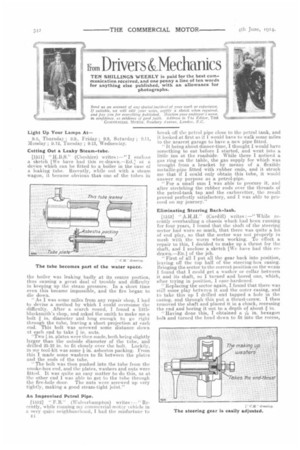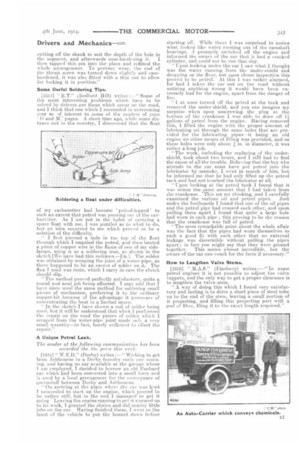from Drivers &Mechanics TEN SHILLINGS WEEKLY is paid for the
Page 24

Page 25

If you've noticed an error in this article please click here to report it so we can fix it.
best communication rgceived, and one penny a line of ten words for anything else published, with an allowance for photographs.
Light Up Your Lamps At
9.8, Thursday ; 9.9., Friday ; 9.9, Saturday ; 9.11, Monday ; 9.12, Tuesday ; 9.13, Wednesday.
Cutting Out a Leaky Steam-tube.
[1511] " H.B.S." (Cheshire) writes :—"I enclose a sketch [We have had this re-drawn_—Ed.; or device which can be fitted to a boiler in the case of a leaking tube. Recently, while out with a steam wagon, it became obvious thati one of the tubes in the boiler was leaking badly at its centre portion, thus causing a great deal of trouble and difficulty in keeping up the steam pressure. In a short time even this became impossible, and the fire began to die down.
"As I was some miles from any repair shop, I had to devise a method by which I could overcome the difficulty. After a search round, I found a little blacksmith's shop, and asked the smith to make me a. bolt .4 in. diameter and long enough to go right through the tube, leaving a short projection at each end. This bolt was screwed some distance down. at each end to take in. nuts.
"Two l in. plates were then made, both being slightly larger than the outside diameter of the tube, and drilled 25-32 in, to fit closely over the bolt. Luckily, in my tool-kit was some in. asbestos packing. From this I made some washers to fit between the plates and the ends of the tube.
"The bolt was then pushed into the tube from the smoke-box end, and the plates, washers and nuts were fitted. It was quite an easy matter to do this, as at the other end I was able to get to the tube through the fire-hole doorThe nuts were screwed up very tightly, making a good steam-tight ioint."
An Improvised Petrol Pipe.
[1512] " (Wolverhampton) writes :—" Re cently, while running my commercial-meter vehicle in a very quiet neighbourhood, I had the misfortnne to El break off the petrol pipe close to the petrol tank, and it looked at first as if 1 would have to walk some miles to the nearest garage to have a new pipe fitted.
"It being about dinner-time, I thought I would have something to eat before I started, and went into a little inn at the roadside. While there I noticed a gas ring on the table, the gas supply for which was brought from a bracket by means of a flexible metallic-pipe fitted with rubber ends, and it struck me that if I could only obtain this tube, it would answer my purpose as a petrol-pipe.
"For a small sum I was able to procure it, and after stretching the rubber ends over the threads of the petrol-tank tap and the carburetter, the result proved perfectly satisfactory, and I was able to proceed on my journey."
Eliminating Steering Back-lash.
[1513] " (Cardiff) writes :—" While re cently overhauling a chassis which had been running for four years, I found that the shaft of the steering sector had worn so much, that there was quite a lot of end play, so that the sector was not properly in mesh with the worm when working. To effect a, repair to this, I decided to make up a thrust for the shaft, and I enclose a sketch [We have had this r("!-drawn.—En.] of the job. " First of all I put all the gear back into position, leaving off the top half of the steering-box easing. Bringing the sector to the correct position on the WGYM 1 found that I could get a washer or collar between it and its shaft, so I turned and bored one, which, after trying in position, I ease-hardened. 'Replacing the sector again, I found that there was still some play between it and the outer easing, and to take this up I drilled and tapped a hole in the casing, and through this put a thrust-eorevr. I then removed the shaft and placed it in a chuck, recessing the end and boring it out to a depth of about in.
"Having done this, I obtained a T7T in, hexagon bolt and turned the head down to fit into the recess,
cutting off the shank to suit the depth of the hole in
the segment, and afterwards ease-hardening it. I then tapped this pin into the place and refitted the whole arrangement. To prevent wear, the end of the thrust screw was turned down slightly and casehardened, it was also fitted with a thin nut to allow for locking it in position."
Some Useful Soldering Tips.
[15141 " R.T." (Bedford Hill) writes Some of the most interesting problems which have to be solved by drivers are those which occur on the road, and I think that one which I succeeded in overcoming may lee of interest to some of the readers of your 1) and M.' pages. A short. time ago, while some distance out in the country, I discovered that the float of my carburetter had become 'petrol-logged' to such an extent, that petrol was pouring oui of the carburetter. As I am not in the habit of carrying a spare float with me, I was puzzled as to what to do, but an idea occurred to mewhich proved to be a solution of the difficulty. " I first pierced a hole in tile top of the float through which I emptied the petrol, and then heated a piece of copper wire in the flame of one of my sidelamps, using it as a soldering iron, as shown in the sketch [We have had this redrawn—ED.]. The solder was obtained by scraping the joint of a water-pipe, as there hapnened to be an excess of solder on it. The flux I usea was resin, which I carry in ease the clutch should slip.
" The method proved perfectly satisfaetory, quite a sound and neat job being effected. I may add that have since used the same method for soldering small pieces of mechanism, preferring it to the ordinary copper-hitbecause of the advantage it possesses of concentrating the heat in a limited space.
" In the sketch I have shown a rod of solder being used, but it will be understood that when l performed the repair on the road the pieces of solder which I scraped from the water-pipe joint made °illy a very small quantity—in fact, barely suffieient to effect the repair."
A Unique Petrol Leak.
The sender of the following communication has been awarded the 10s. prize this week.
[1515] " WED." (Derby) writes:—" Wishing to get from Ashbourne to a Derby foundry early one morning. and having no car available atthe garage where I am employed, I decided -to borrow an old Panhard car which had been -converted into a small. lorry and is used by a lo-&l greengrocer for the conveyance of greenetuff between Derby and A shbourne.
" On arriving at the place where the car was kept T proceeded to start up the engine, which proved to he rather stiff, but in the end I managed to get it going Leaving the engine running to get it. warmed imp to its work, I greased the chains and did sundry little jobs on the car. Raving finished these, I went to the front of the vehicle to put the bonnet down before starting off.. While there I was surprised to notice what looked like water running out of the camshaft bearings. I promptly switched off the engine and informed the owner of the car that it had a cracked cylinder, and could not be ruu that day. "Upon looking under the car I saw what I thought was the water running from the under-shield and dropping on the floor, but upon closer inspection this proved to be petrol. At this I was rather alarmed, for had I taken the car out on the road without noticing anything wrong it would have been extremely bad for the engine, apart from the danger of fire.
" 1 at once turned off the petrol at the tank and removed the under-shield, and you can imagine my surprise when up-on unscrewing the plug -at the bottom of the crankcase I was able to draw off 14 gallons of petrol from the engine. Having removed this, I filled the engine with the proper amount. of lubricating oil through the same holes that are provided for the luhrieating pipes— it being an old engine no other means of filling was provided, and as these holes were only about in. in diameter, it was rather a long job.
" The work, including the replacing of the undershield, took about two hours, and I still had to find the cause of all the trouble. Believing that the boy who attends to the car must have put petrol into the lubricator by mistake, I went in search of him, but he informed roe that he had only filled up the petrol tank and had not touched the lubricator at all.
"Upon looking at the petrol tank I found that it was minus the same amount that had taken from tile crankcase. 'This set. me thinking, and I carefully examined the various 1jil and petrol pipes. Just under the footboards I found that one of the oil pipes and the petrol pipe had crossed each other, and upon pulling them apart I found that quite a large hole had worn in each pipe ; this proving to be the reason that the crankcase was full of petrol.
"The most remarkable point about the whole affair was the fact that the pipes had worn themselves to such a good fit with each other that no external leakage was discernible without pulling the pipes apart ; in fact you might say that they were ground together. This seems almost incredible, but the owner of the car can vouch for the facts if necessary."
How to Lengthen Valve Stems.
[1516] " M.A.S." (Finsbury) writes :—" In _some petrol engines it is not possible to adjust the valve tappets, arid the only way to get a proper -clearance is to lengthen the valve stem.
"A way of doing this which I found very satisfactory and lasting is to drive a -short piece of steel tube on to the end of the ste-m, leaving a small portion of itprojecting,andfilling this projecting part with a pad of fibre, filing it to the exact length required.''


























